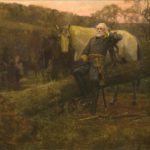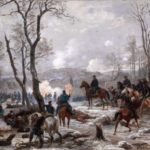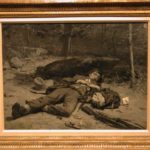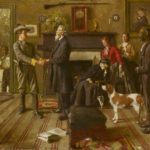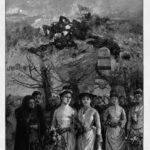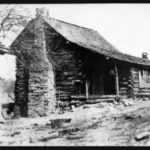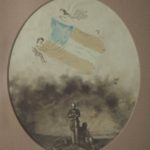Commemorative Works of Art

Although Tennessee saw more military action during the Civil War than any state save Virginia, relatively few painters explored the subject. Among them were Gilbert William Gaul (1855-1919) and Carl Gutherz (1844-1907). While neither was born in the South, both were deeply moved by memories and experiences associated with the Civil War. Gaul was born in New Jersey, and studied art in the Northeast. In 1881 he inherited a family farm in Van Buren County, Tennessee, near Fall Creek Falls. Gaul became famous for grand Civil War battle scenes reproduced in Harper’s Weekly and elsewhere, but perhaps his most compelling pictures focus upon the tragedy and loss associated with the conflict. Among the most poignant — and one fully steeped in the melancholic tradition of the Lost Cause — is Leaving Home. It shows a gallant young Confederate saying farewell to family and enslaved servants. No less forlorn is Gaul’s The Last Letter, which depicts a dead Confederate soldier with a missive from a loved one open on his chest.

Carl Gutherz.
Sunset after Appomattox. 1897.
Memphis Brooks Museum of Art, Memphis, TN. Gift of Marshall and Elizabeth Goodheart.
This painting by Carl Gutherz is thought to have been exhibited at the 1897 Tennessee Centennial Exposition.
Since it is not in the catalog of the Fine Arts Department or the Woman’s Department, it may have been
displayed in one of the other buildings.
View Object Details
The strains of sorrow found in Gaul’s work are echoed in the paintings of Carl Gutherz. Born in Switzerland, the artist spent his youth in Union-occupied Memphis. His brother, Frederick, served in the Confederate army. Gutherz’s earliest Civil War-related image is The Flight of the Warrior’s Soul — a mournful picture suggesting the apotheosis of fallen Confederates. Gutherz’s Missing is even more somberly spiritual. It depicts a beautiful young soldier lying dead in a wooded setting–a martyred saint in the wilderness. Painted in Paris and exhibited at the Salon there, the canvas reflects the artist’s distaste for violence and strife. Among Gutherz’s most ambitious paintings was Sunset after Appomattox, an expansive canvas showing Confederate General Robert E. Lee following the surrender. These works, and others by Gutherz, Gaul, and a handful of other artists, reflect decades of public interest in recalling the glories of battle, the desire to vindicate the South, or a hope for healing the sorrows and wounds caused by the war’s passage.
— Stanton Thomas, Ph.D., Curator of European and Decorative Art, Memphis Brooks Museum of Art
Further Reading
- John F. Reeves, Gilbert Gaul (Exhibition catalogue, Cheekwood Museum of Art, Nashville, Tennessee and Huntsville Museum of Art, Huntsville, Alabama, 1975)
- Stanton Thomas, “Long Shadows of Blue and Gray: Carl Gutherz and the Civil War,” in Carl Gutherz: American Visions and Academic Ideal (Memphis: Toof Commercial Printing, 2009), 117-141




